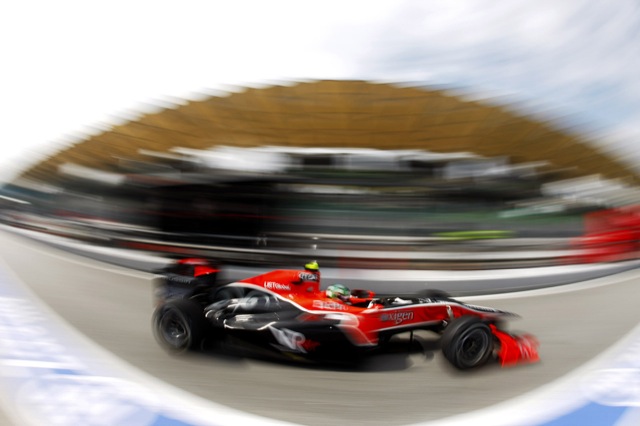Few people realised before the French Grand Prix of 1954 just what a bold, brave and well-calculated move Juan Manuel Fangio had made. The thought of the Argentine World Champion dropping the three-times winning Maserati to drive a Daimler-Benz was difficult to understand. While the Italian machine wasn’t instantly fast, at the hands of Fangio it had become a winner. To switch teams mid-season was considered foolish enough, but to make the move to a team that was yet to compete in the modern-day championship… many thought Juan Manuel had finally lost his marbles.
Of course Fangio had not lost any of his mental prowess. Despite winning two races in 1954 with the Maserati, including his final before making the move, it was most certainly not to be his last victory of the year. Taking control of the W196, considered by many to be one of the finest Formula One cars to have ever been built, the Argentine went on to win a further four races and take his second world championship, beating Ferrari driver Jose Froilan Gonzalez 42 points to 25.14.

The most memorable victory though was the first. Few manufacturers/constructors win on their first attempt, and although Daimler-Benz had previous with motor racing, it was in essence the German car-builders first Formula One Grand Prix.
Like Brawn 54 years later, incidentally powered by a Mercedes-Benz engine, one-two grid slots followed by a one-two finish was sealed in astonishing dominance. Fangio and fellow Benz driver Karl Kling both finished the 1954 French Grand Prix 0.1s apart and one lap up on third placed driver, Robert Manzon in the Ferrari. The fastest lap of the race was set by the third Mercedes driver participating, Hans Hermann. Unfortunately, the German retired after sixteen laps. The dominance of the car and drivers though was felt throughout the motorsporting world. Mercedes had arrived in Formula One.
The following season, Benz continued with the formidable W196 and Fangio, Kling and Hermann continued to drive the Silberpfeiles and were joined by Stirling Moss, Andre Simon and Piero Taruffi. The car was already close to a year old, but unlike modern-day Formula One, this had less of an effect as many cars were carried over from one season to another.
Evidence of this non-effect can be seen in the 1955 driver’s championship table. Heading the chart with his third title, Juan Manuel Fangio collected 40 points, 17 more than Stirling Moss in second. Piero Taruffi finished the season in sixth with a fine drive to second in the final race of the year. Karl Kling ended his season’s racing in eleventh while Hans Hermann, who only completed one race, still managed to score a point.
Unfortunately for Formula One though, 1955 would be the final year Mercedes competed in the sport for a very long time. The season was overshadowed by a horrific accident at Le Mans, killing 80 spectators and driver Pierre Levegh. Many races were cancelled following the accident, including two grands prix, Switzerland banned motorsport and Mercedes-Benz withdrew from Formula One.
They won their first race in 1954, they won the last in 1955. Although short-lived, Mercedes had made a significant mark on Formula One in less than two seasons. But as can be seen on the grid for the 2010 championship, Mercedes aren’t quite done with Formula One just yet.
The German marque actually returned to the sport in 1993 by supplying Sauber’s new entry with engines. Although unofficial, the Swiss outfit’s cars were powered by Mercedes engines. The partnership became official in 1994 and by 1995, they were found in the McLarens as Ron Dennis began recharging his team into championship winners. Mercedes bought a minor shareholding in McLaren and the partnership between the pair continues to this day.
With manufacturers dropping out of the sport, head of Mercedes motorsport Norbert Haug brokered a deal to work with Force India in 2008, supplying engines and technical assistance. In early 2009 Ross Brawn decided on Benz-power for the newly-acquired Honda team, renamed Brawn after the team principal. Brawn dominated the early part of season, taking six of the first seven races and a further two before wrapping up the driver’s and constructor’s titles. This was enough to convince the manufacturer and Mercedes relinquished their stake in McLaren and bought a majority share in Brawn, further rebranding the team and becoming, for the first time in their Formula One career, a fully-fledged constructor (of manufacturer qualities, of course).

Fifty-five (ish) years separate the 1955 Italian Grand Prix and the 2010 Bahrain Grand Prix, and although Michael Schumacher and Nico Rosberg failed to display the dominance that has become synonymous with the silver arrows, the pair still managed to bring the cars home in the points at their returning race. And so continues the history of the three-pointed star in Formula One.
Fangio image licensed under the Creative Commons Attribution-Share Alike 2.0 Germany license.
MercedesGP/Schumacher images © Mercedes-Benz.



















[…] place to be a fly-on-the-wall at the moment. Along with the marque’s return to Formula One after 55 years of non-competing or being simply an engine supplier, they have also hired two drivers with whom come a lot of […]